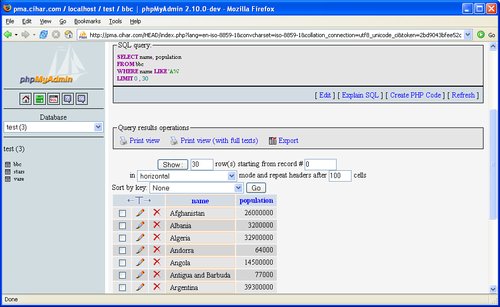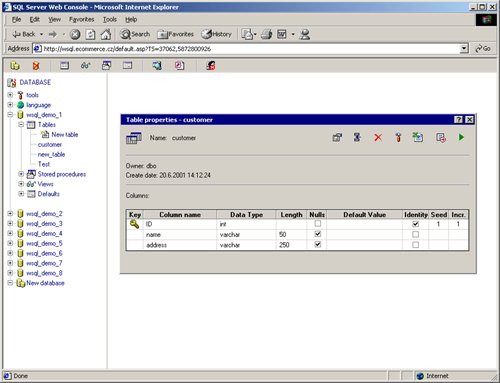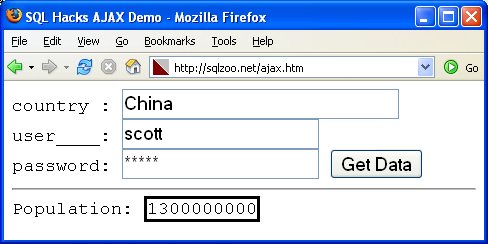Hack 100. Run SQL from a Web Page


A web-based interface to your SQL machine can be useful. Fortunately, plenty of options are available to you.
You can connect to your SQL database in a number of ways. You can use the command-line interface as shown in [Hack #1], and you can execute SQL from a programming language as shown in [Hack #2]. Another option is to work from a web browser. Either each vendor has its own mechanism for this, or a third-party product is available.
12.5.1. MySQL
phpMyAdmin (http://www.phpmyadmin.net), shown in Figure 12-1, is a tool that allows MySQL administration over the Web. It is popular with web hosting companies because it allows their clients to control MySQL accounts without requiring shell access.
Figure 12-1. The phpMyAdmin user interface

The phpMyAdmin tool set includes step-by-step forms for most of the commonly used facilities of SQL. Creating a table is relatively intuitive; setting permissions is a breeze. After you click the Go button, it shows you the SQL that has been generated so that you can easily find the exact syntax for those obscure SQL commands that you rarely use. But you also have the opportunity to execute arbitrary SQL if you find the interface inadequate.
12.5.2. SQL Server
For SQL Server, you can use the Web Data Administrator utility available from Microsoft, and shown in Figure 12-2.
Figure 12-2. Microsoft Web Data Administrator

You can also use WebSQL Console, available from http://www.websqlconsole.com, and shown in Figure 12-3.
Figure 12-3. WebSQL console

12.5.3. Oracle
Oracle provides a web interface: iSQL*Plus, which is shown in Figure 12-4.
Figure 12-4. iSQL*Plus

By default, the iSQL*Plus interface is available at http://localhost:5500/em/console/logon/logon for administration and at http://localhost:5560/isqlplus/dynamic for general SQL access.
12.5.4. PostgreSQL
The program phpPgAdmin, available at http://www.phppgadmin.org, allows you to run queries from a web page, and it provides access to other administrative functions. It is shown in Figure 12-5.
Figure 12-5. phpPgAdmin

12.5.5. Hacking the Hack
You can exploit an SQL web-based interface and use it as the server-side script for your AJAX applications. An AJAX page usually features a client-side page that runs in a browser and a server-side script that is invoked from the client. In an AJAX application, you use JavaScript to send queries to the server and then make changes to the current page using JavaScript DOM methods.
The example program shown in Figure 12-6 runs inside a browser; the code that follows is a plain HTML page with some embedded JavaScript. The only server-side script needed is phpMyAdmin.
The user can specify the name of a country, his SQL username, and his password. The client-side script formulates an SQL query to get the population for that country. It sends the query to the general-purpose SQL web interface and then displays the result without refreshing the whole page.
Figure 12-6. AJAX demonstration

|
The code for this example is a static HTML page that does not need to be interpreted at the web server; all the processing is done on the client:
SQL Hacks AJAX Demo
country :
user___ _:
password:
Population:
Here's an explanation of how this works:
Line 4
The SQL statement is assembled using JavaScript string functions. Note that the escaping of the quote does not protect this application from an SQL injection attack, but it does prevent an SQL syntax error when querying the country Cote d'Ivoire.
Line 7
phpMyAdmin encodes the SQL and other parameters as CGI get variables, so the URL contains each value required. It is also possible to perform POST requests from an AJAX application.
Line 24
You use responseText to get the data. A hidden
is set to the response from phpMyAdmin. Although the user cannot see the response, the browser parses it and makes it available to DOM methods in JavaScript.
Line 33
The function show(i) extracts the TD element i from the table with the ID table_results. The entire result set is stored in this array; if the SQL statement resulted in more than one value, the other results would also be available.
|
12.5.6. Using Other Web Interfaces
You can use a similar technique for the Oracle, PostgreSQL, and SQL Server web interfaces; however, a little investigation is required.
12.5.6.1. Authentication
You need to know how the authentication is managed. In phpMyAdmin the authentication is via HTTP and the JavaScript open command includes parameters for the username and password. In Oracle's iSQL the authentication is managed by a cookie. It is possible to obtain the cookie by making requests from JavaScript.
12.5.6.2. CGI parameters
You need to know the name of the CGI parameters. In phpMyAdmin the SQL statement is in sql_query, and for Oracle's iSQL the SQL is in the CGI parameter script.
12.5.6.3. Processing results
You need to know the structure of the results page in order to show the values required. For phpMyAdmin we have chosen to fetch the page intended for printing. This has a simple structure, and it's easy to probe the results of the query using JavaScript DOM functions such as getElementById and getElementsByTagName.
12.5.7. Security
This technique relies on the user having access to an SQL account on the database server. You might safely use an anonymous account as long as you take the precautions outlined in "Allow an Anonymous Account" [Hack #97].
SQL Fundamentals
- SQL Fundamentals
- Hack 1. Run SQL from the Command Line
- Hack 2. Connect to SQL from a Program
- Hack 3. Perform Conditional INSERTs
- Hack 4. UPDATE the Database
- Hack 5. Solve a Crossword Puzzle Using SQL
- Hack 6. Dont Perform the Same Calculation Over and Over
Joins, Unions, and Views
- Joins, Unions, and Views
- Hack 7. Modify a Schema Without Breaking Existing Queries
- Hack 8. Filter Rows and Columns
- Hack 9. Filter on Indexed Columns
- Hack 10. Convert Subqueries to JOINs
- Hack 11. Convert Aggregate Subqueries to JOINs
- Hack 12. Simplify Complicated Updates
- Hack 13. Choose the Right Join Style for Your Relationships
- Hack 14. Generate Combinations
Text Handling
- Text Handling
- Hack 15. Search for Keywords Without LIKE
- Hack 16. Search for a String Across Columns
- Hack 17. Solve Anagrams
- Hack 18. Sort Your Email
Date Handling
- Date Handling
- Hack 19. Convert Strings to Dates
- Hack 20. Uncover Trends in Your Data
- Hack 21. Report on Any Date Criteria
- Hack 22. Generate Quarterly Reports
- Hack 23. Second Tuesday of the Month
Number Crunching
- Number Crunching
- Hack 24. Multiply Across a Result Set
- Hack 25. Keep a Running Total
- Hack 26. Include the Rows Your JOIN Forgot
- Hack 27. Identify Overlapping Ranges
- Hack 28. Avoid Dividing by Zero
- Hack 29. Other Ways to COUNT
- Hack 30. Calculate the Maximum of Two Fields
- Hack 31. Disaggregate a COUNT
- Hack 32. Cope with Rounding Errors
- Hack 33. Get Values and Subtotals in One Shot
- Hack 34. Calculate the Median
- Hack 35. Tally Results into a Chart
- Hack 36. Calculate the Distance Between GPS Locations
- Hack 37. Reconcile Invoices and Remittances
- Hack 38. Find Transposition Errors
- Hack 39. Apply a Progressive Tax
- Hack 40. Calculate Rank
Online Applications
- Online Applications
- Hack 41. Copy Web Pages into a Table
- Hack 42. Present Data Graphically Using SVG
- Hack 43. Add Navigation Features to Web Applications
- Hack 44. Tunnel into MySQL from Microsoft Access
- Hack 45. Process Web Server Logs
- Hack 46. Store Images in a Database
- Hack 47. Exploit an SQL Injection Vulnerability
- Hack 48. Prevent an SQL Injection Attack
Organizing Data
- Organizing Data
- Hack 49. Keep Track of Infrequently Changing Values
- Hack 50. Combine Tables Containing Different Data
- Hack 51. Display Rows As Columns
- Hack 52. Display Columns As Rows
- Hack 53. Clean Inconsistent Records
- Hack 54. Denormalize Your Tables
- Hack 55. Import Someone Elses Data
- Hack 56. Play Matchmaker
- Hack 57. Generate Unique Sequential Numbers
Storing Small Amounts of Data
- Storing Small Amounts of Data
- Hack 58. Store Parameters in the Database
- Hack 59. Define Personalized Parameters
- Hack 60. Create a List of Personalized Parameters
- Hack 61. Set Security Based on Rows
- Hack 62. Issue Queries Without Using a Table
- Hack 63. Generate Rows Without Tables
Locking and Performance
- Locking and Performance
- Hack 64. Determine Your Isolation Level
- Hack 65. Use Pessimistic Locking
- Hack 66. Use Optimistic Locking
- Hack 67. Lock Implicitly Within Transactions
- Hack 68. Cope with Unexpected Redo
- Hack 69. Execute Functions in the Database
- Hack 70. Combine Your Queries
- Hack 71. Extract Lots of Rows
- Hack 72. Extract a Subset of the Results
- Hack 73. Mix File and Database Storage
- Hack 74. Compare and Synchronize Tables
- Hack 75. Minimize Bandwidth in One-to-Many Joins
- Hack 76. Compress to Avoid LOBs
Reporting
- Reporting
- Hack 77. Fill in Missing Values in a Pivot Table
- Hack 78. Break It Down by Range
- Hack 79. Identify Updates Uniquely
- Hack 80. Play Six Degrees of Kevin Bacon
- Hack 81. Build Decision Tables
- Hack 82. Generate Sequential or Missing Data
- Hack 83. Find the Top n in Each Group
- Hack 84. Store Comma-Delimited Lists in a Column
- Hack 85. Traverse a Simple Tree
- Hack 86. Set Up Queuing in the Database
- Hack 87. Generate a Calendar
- Hack 88. Test Two Values from a Subquery
- Hack 89. Choose Any Three of Five
Users and Administration
- Users and Administration
- Hack 90. Implement Application-Level Accounts
- Hack 91. Export and Import Table Definitions
- Hack 92. Deploy Applications
- Hack 93. Auto-Create Database Users
- Hack 94. Create Users and Administrators
- Hack 95. Issue Automatic Updates
- Hack 96. Create an Audit Trail
Wider Access
- Wider Access
- Sharing Data Across the Internet
- Hack 97. Allow an Anonymous Account
- Hack 98. Find and Stop Long-Running Queries
- Hack 99. Dont Run Out of Disk Space
- Hack 100. Run SQL from a Web Page
Index
EAN: 2147483647
Pages: 147
- Structures, Processes and Relational Mechanisms for IT Governance
- Integration Strategies and Tactics for Information Technology Governance
- An Emerging Strategy for E-Business IT Governance
- Assessing Business-IT Alignment Maturity
- Technical Issues Related to IT Governance Tactics: Product Metrics, Measurements and Process Control

